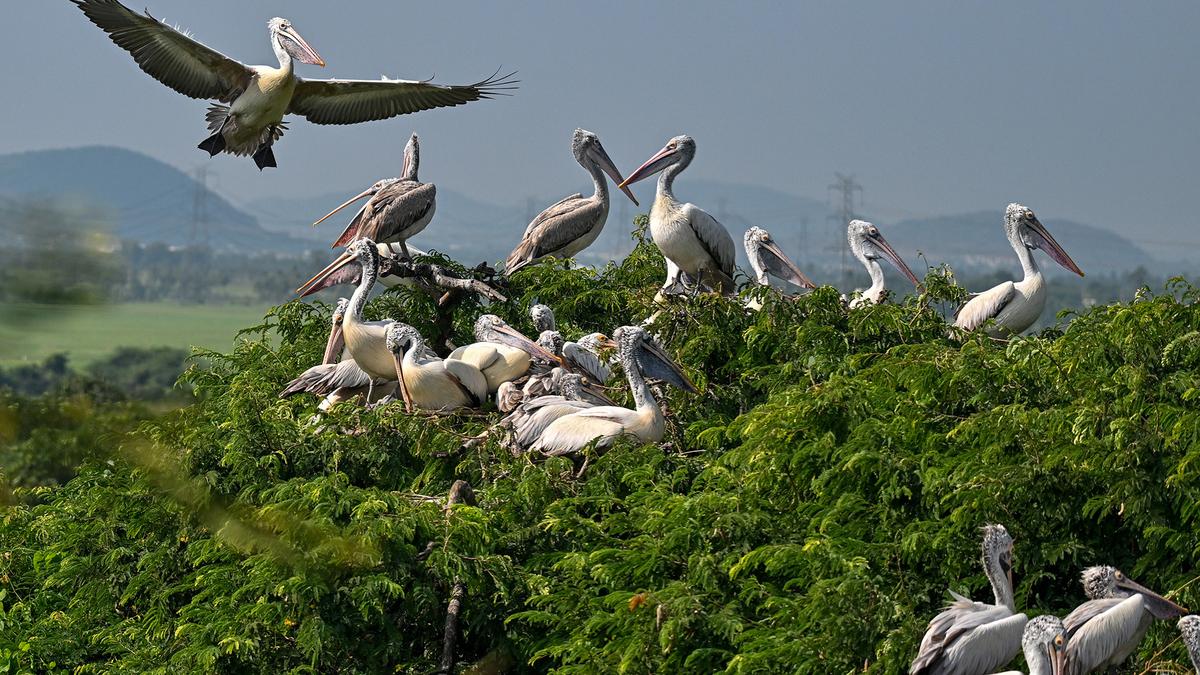
Telineelapuram: Migratory birds arrive at the birding hotspot, marking a promising breeding season
The Hindu
Experience the annual migration of spot-billed pelicans and painted storks at Telineelapuram, a haven for birdwatchers in Andhra Pradesh.
The soft golden light of dawn breaks through the winter mist at Telineelapuram, illuminating the sprawling tamarind trees that house the season’s most awaited guests from Siberia — spot-billed pelicans and painted storks. The crisp winter air carries the faint rustling of leaves, the gentle hum of crickets, and the distant resonant calls of birds. A bustling haven for migratory birds at Srikakulam district of Andhra Pradesh, the quaint village of Telineelapuram stirs awake as groups of birders gather, armed with binoculars, cameras, and a sense of awe. They tread carefully along the narrow paths leading to the watch tower to get vantage views of the nesting grounds, their hushed conversations punctuated by excited whispers.
Each year, this serene spot witnesses the arrival of painted storks and spot-billed pelicans from the last week of September, heralding the onset of the migratory bird season. With their striking plumage and graceful flight, these winged visitors create a vibrant spectacle against the backdrop of the sprawling green canopy of tamarind and Prosopis trees.
This year, the migration has been particularly promising, with 142 spot-billed pelican nests and 268 painted stork nests reported till the first week of December. According to Visweswara Rao, a watchman with the Andhra Pradesh Forest Department, the numbers are expected to rise further owing to favourable weather conditions and abundant water resources this year. “We are optimistic about a thriving season, especially with plentiful rains ensuring adequate food supply,” he shares. Last year, the season recorded a total of 142 pelican nests and 268 nests of painted storks.
Spot-billed pelicans were the first to arrive, marking their presence on September 27. Painted storks followed a few weeks later, arriving on October 20. These birds have established a breeding ground spread across 500 metres, with tamarind trees serving as their primary nesting sites. The painted storks, in particular, have shown remarkable breeding success, with a 95% success rate compared to the 50% success rate of spot-billed pelicans, a species listed as Near Threatened in the IUCN Red List. The migratory bird season that begins from September every year ends by the first week of March.
Birding enthusiasts and Nature lovers have already begun flocking to Telineelapuram in groups, eager to witness this marvel of Nature. The best time to observe the hatchlings, say experts, is the third or last week of December, when the nests brim with life and activity. “This is the time when you can view and photograph the birds along with their chicks and eggs,” says Ban Nanda, a photographer and member of photography groups from Visakhapatnam. Nanda, who has been visiting the avian paradise over the past decade, says that the breeding season used to begin much earlier; but in recent years due to various factors, it has gotten delayed.
The tranquil setting, rich biodiversity and accessibility make Telineelapuram an ideal destination for both amateur and professional photographers aiming to document this annual migration. According to Nanda, selecting the right gear is crucial for achieving striking shots. He suggests carrying 70-200 mm and 200-400mm lenses, which offer “excellent” focal length flexibility to capture both close-up details and birds in their natural habitat. “The best time for photography is the golden hours of early morning when the soft light highlights the birds’ vibrant plumage against serene backdrops,” he says and adds: “Patience and maintaining a safe distance are key, ensuring that the birds are not disturbed while you observe their natural behaviour.”
As December arrives, the breeding season has just begun to set in. Juvenile storks stretch their fledgling wings, testing the morning breeze, while adult pelicans return from nearby water bodies with their beaks stuffed with fish. The interplay of activity — nesting, feeding, and grooming — creates a dynamic tableau that captivates onlookers. The birds can be best viewed in their habitat from a watch tower with three floors, each at a different level of elevation.

The Karnataka government has drafted a comprehensive master plan for the integrated development of Kukke Subrahmanya temple, the State’s highest revenue-generating temple managed by the Hindu Religious Institutions and Charitable Endowments Department. The redevelopment initiative is estimated to cost around ₹254 crore and aims to enhance infrastructure and facilities for devotees.












